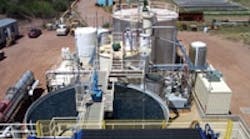From his office at Bioteq Environmental Technologies Inc.'s headquarters in Vancouver, British Columbia, Brad Marchant, the company's president and CEO, sees a niche water market that's not likely to dry up anytime soon. Focused on the mining industry, his $5 million, 6-year-old company builds and operates plants that treat acid-contaminated water.
"The [environmental] regulations are getting more and more strict -- not just here in North America, but worldwide -- and that provides us with more opportunities for water treatment sites," explains Marchant. And, he adds, "As the mining industry grows in some developing countries like China, so does their need to treat water."
The cleanup cost of acid drainage from mining has been estimated to be between $36 billion and $72 billion in the U.S., and in Canada it's estimated to be about $6 billion. Bioteq claims to have a better idea for treating mine wastewater, different from conventional treatment, which uses lime to reduce the acidity of mine wastewater and leaves a sludge that contains copper, zinc, nickel and other heavy metals and which must be stored in the ground. Bioteq's patented process, using sulfur and other reagents, allows for selective recovery of the metals and prepares the water for other purposes.
"The sustainable aspect of that process is that the valuable metals that are recovered can pay for the water treatment itself," says Marchant. "The water can be discharged to the environment. It can be reused by the industry. Or it can be used [in] agricultural uses. It's been treated to the point that it's environmentally very safe."
| See Also |
Billions And Billions
All told, spending for water processing runs into the hundreds of billions of U.S. dollars. Charlotte, N.C.-based Si Givens, vice president and market segment director for water and process at CH2M Hill, an engineering, construction and operating firm, estimates about $400 billion a year is spent globally on processing water.
Drawing from Environmental Business International data, Givens figures about $120 billion a year is spent in the U.S., with state and local governments, including major cities, accounting for about two-thirds of the total, roughly $80 billion, and industry spending the other third of the total.
Of the $120 billion total, about two-thirds to three-fourths of the spending goes for the building of new water treatment facilities and the annual operating and maintenance costs of running water treatment facilities. The rest goes to design firms, such as CH2M Hill, for chemicals (Givens estimates $5 billion to $6 billion annually) and for equipment. The U.S. water "market" is growing at about 4% annually, Givens says.
At CH2M Hill, what Givens calls the "bricks and mortar pieces of water" -- the water treatment plants and the wastewater treatment plants for manufacturing facilities -- are "far and away" what companies contact them about. However, the "softer side" is becoming a bigger part of the market, he relates. It's not about building things but rather about getting advice on industrial water resources management, says Givens.
"Companies want help in how to look at water from a macro picture in their business: how to be a good steward and a good citizen in the locations they are in and balance all the issues around water availability, water ownership, scarcity issues and the risks that are involved in having to deal with water," he notes.
Givens adds, though, that "there are a lot of business risks that people are taking on if they can't source the water they need to manufacture their goods." For example, he mentions that both Coca-Cola and Perrier in recent years have had issues with contamination of water. "Water can make things very critical for a company very quickly. So helping companies understand water issues, and water resources issues and how to be a good corporate citizen is an important part of the business."
The "softer side" has a "natural" side. "Companies are looking toward natural treatment systems versus more mechanical-based treatment. And there are benefits from that," says Givens. "Natural treatment systems -- wetlands -- do a great job of removing pollutants [while] enhancing natural habitants. So you sort of get a two-for-one, in some instances, when you're able to use the natural treatment system versus a mechanically intense treatment system."
Sometimes natural treatment is coupled with mechanical treatment. "The mechanically intense treatment system will be the first line of treatment, and then the natural treatment system will be used to 'polish' the last bit of contaminant before discharge," he explains. "We're doing that more and more for both cities and industries. Cities have been a little more in the forefront, but industries are quickly catching up."
Alcoa Inc., for instance, is using natural treatment systems, with a dramatic improvement in discharged water quality and the promise of lower costs of operation.



